An essential principle not only to screenwriting but also the wider fundamentals of storytelling, plants and payoffs are one of the most effective ways of involving the audience and embedding clever twists, turns, and surprises throughout your screenplay.
Premised upon the notion that any element introduced into a script must later prove significant, plants and payoffs exploit the human tendency to make mistakes, overlook details, and misconstrue information. In doing so, they also succeed in tapping into our desire to prove ourselves right and make logical connections.
In short – if you are going to draw attention to something, make it matter. The concept works to endow even the smallest details of your film with greater purpose, encouraging the audience to pay attention and make connections.
For such a simple concept, plants and payoffs have unrivalled implications for a screenplay’s success. So let’s take a look at exactly what they mean and how to implement them in your own screenplay.
Table of Contents
What Are Plants and Payoffs?
Plants and payoffs are all about planting seeds for the audience. Seeds that will eventually have sprouted into a meaningful idea or concept.
Plants are kind of like hidden pointers for the audience, subtle hints that allow us to make assumptions about forthcoming events or clues to look back on when they later emerge as crucial to the plot.
Whether it be a line of dialogue, an object, a character trait, or an action, a plant is any element that will later be returned to.
Any detail introduced into a script must have wider implications for the plot or its characters. If a writer can effectively implement plants and payoffs, details introduced at the beginning of a film/scene will later have garnered greater significance and changed meaning in some way.
This is similar to Chekhov’s gun. This concept emerges from Anton Chekhov’s dramatic principle that every element introduced into a story must be necessary.
“If in the first act you have hung a pistol on the wall, then in the following one it should be fired. Otherwise don’t put it there.”
Anton Chekhov
In addition, plants and payoffs are similar to foreshadowing. However, typically they are more essentially tied up with the story than a moment of foreshadowing will be. Foreshadowing can seed something thematically into the story. Plants and payoffs, meanwhile, are more to do with the balance of the story overall.
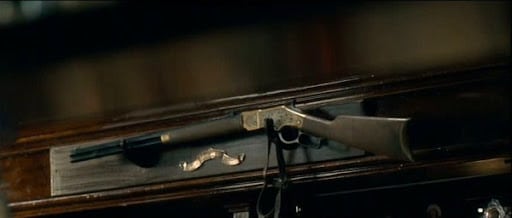
Why Do We Need Plants and Payoffs?
To Connect With The Audience
The most important element of plants and payoffs is the way they work to involve the audience. They make it the audience’s job to recognise the significance of passing details and make meaningful connections. In turn, the audience will feel seen and appreciated.
The best and most effective writers will make the audience feel clever for having spotted the plant earlier in the film. If a writer introduces a detail that has no bearing on the plot, they are making false promises to their audience.
The craftiest, most successful payoffs will have your audience shouting, “I knew it!”, “It was there the whole time”. There are few things more satisfying.
To Avoid Coincidences
Without effective plants and payoffs, a film is liable to be over-reliant on coincidences. Actions and events will seem random or inconsequential and the audience will likely become frustrated by the need to suspend their disbelief.
The audience is more likely to be convinced by unusual, strange or implausible events if they are foreshadowed or set up in some way earlier in the film.
To Sow Consistent Storytelling
Good storytelling is about consistency and focus. And plants and payoffs are a perfect example of such attributes.
Plants and payoffs are about running threads throughout a story. It’s the asking of a question and providing of the answer. And this shows commitment to the plot and/or themes on the writer’s part.
It demonstrates that the writer isn’t thinking and writing from moment to moment and is instead, thinking of the story as a cohesive whole. And this is where storytelling is at its most satisfying, when as an audience you can sit back and feel safe in the writer’s hands, which guide you cohesively and convincingly.

How Do You Set Up a Payoff?
1. Pay Attention to Character Details
Whether this be their likes, dislikes, an object in their home, a childhood memory, or a physical attribute, it is important that any information we are given about a character must be consequential in some way.
Then, in a later scene, re-introduce this detail, demonstrating its significance by having imbued it with new information that serves to complicate our understanding of the character and strengthen their character development.
2. Avoid Hollow Information
Do not introduce an object into a scene if you cannot prove its value. Even more importantly, do not draw attention to something if you cannot prove its value. If you are going to spend any great amount of time discussing a minor detail, its significance must be realised later in the film.
This will make you question every shift of perspective you include. If a character is paying attention to something in particular, the why of them doing so must be purposeful, if not completely clear in that exact moment.
3. Don’t Be Afraid to Break the Rules
Feel free to introduce details that will throw off the audience. Turn plants on their head. Present payoffs that surprise or shock. This will allow for effective plot twists and convincing, unexpected events.
It is often most rewarding for the audience when met with a payoff that they could not have foreseen. When they look back and recognise the plant, they will come to realise how they overlooked or misinterpreted its significance. Get them yelling, “I can’t believe I missed it!”.
Again, this is about making sure that the eventual answer makes sense, even if the question posed initially via the plant is confusing at the time. The audience may be baffled by a focus on a particular object, for example. It might be a strange object that throws the audience off. But if later you can justify this inclusion convincingly, all will make sense.
It’s all about giving everything you include meaning and purpose to the story and not, for example, throwing the audience off for the sake of it.
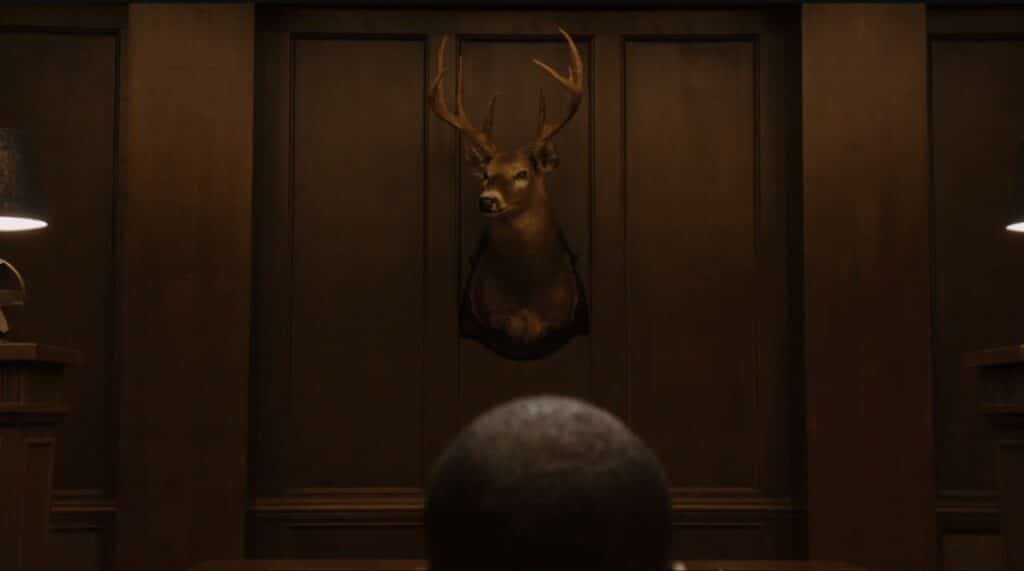
4. Avoid Coincidences
Plants and payoffs are what make your story plausible. If an action or event has not been set up earlier in the film, you are relying on chance and coincidence to move from one sequence to the next.
There is nothing more taxing than an action or event that has appeared completely out of nowhere. All of a sudden, we have lost faith in the film’s authority and can no longer attest to its credibility.
This can be easily avoided by planting crumbs in the lead up to an unusual or outlandish event. If a character is going to set fire to a room, for example, have the matchstick or propensity towards fire be alluded to in an earlier scene.
5. Scatter Throughout
By no means must a plant and playoff span the whole course of a film. A plant doesn’t need to appear in Act 1 and be paid off in Act 3. Plants and payoffs can be briefer, more minute details, confined to a single scene, sequence, or conversation.
To plant something in Act 1 and have it pay off in Act 3 makes the most sense narratively speaking. This is because it mirrors the structure of the film as a whole, with the setup coming in Act 1 and the payoff coming in Act 3, with the struggle for the outcome occurring in Act 2.
However, that doesn’t mean that plants and payoffs aren’t valuable elsewhere. In fact, they can be vital in setting up and maintaining subplots running alongside the main narrative arc.
Examples of Plant and Payoff
We’ve put together a few examples of different plants and payoffs in films.
*Due to the nature of plants and payoffs, this section contains spoilers…
Raising Arizona
One of the Coen brothers’ earliest, most absurd films, Raising Arizona masters the art of using plants and payoffs to achieve a convincing comedic-farce.
Example 1:
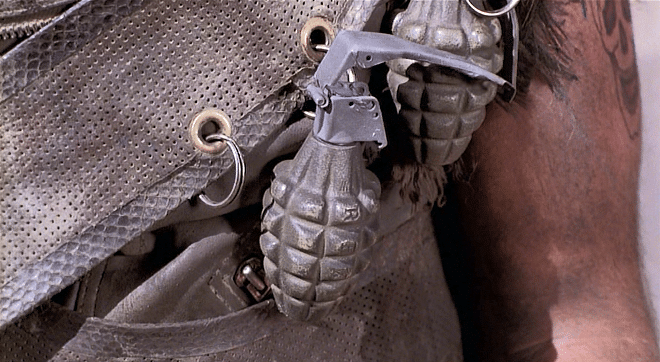
In H.I.’s dream from hell, he has a vision of Leonard Smalls, the bounty hunter, raising fury on nature as he rides furiously on his motorcycle through the Arizona desert.
- Tearing along the highway, we get a close up of multiple hand grenades attached to Small’s motorcycle jacket.
- He then proceeds to pull out the pin from one of the grenades with his mouth, throw it onto the side of the road, and blow up an innocent bunny rabbit. Plant.
At the close of the film, H.I. and Smalls are engaged in a fight to the death.
- Unbeknown to the audience, H.I. cleverly removes the pin from a grenade on Smalls’ jacket.
- Pan to H.I., cowering away from Smalls, clutching a grenade pin. Smalls erupts in a cloud of smoke and fire.
- Killed by his own grenade. Payoff.
Example 2:
H.I.’s woodpecker tattoo.
- First shown in a clip of H.I. with his prison gang, sleeves rolled up, tattoo on display, the tattoo is symbolic of H.I.’s role in a criminal gang.
- The tattoo pokes out from H.I.’s shirt across the course of the film and is often most visible in scenes with his fellow criminals.
It is during his final fight scene, however, when the woodpecker acquires its greatest significance.
- Born across the chest of Leonard Smalls, there we see it, H.I.’s tattoo. Payoff.
- H.I. and Smalls are cut from the same cloth. Upon realising, H.I. appears almost guilty. But only almost.
The payoff relies on the audience having noticed H.I.’s tattoo and determined its accompanying significance.
Get Out
Jordan Peele’s nail-biting horror, Get Out, scatters plants and payoffs throughout, using each set-up to create suspense and keep the audience guessing. The result is an uncanny film that has the audience constantly seeking out clues.
Example 1:
Trapped in the games room, Chris notices some loose cotton stuffing in the arm of the chair. Plant.
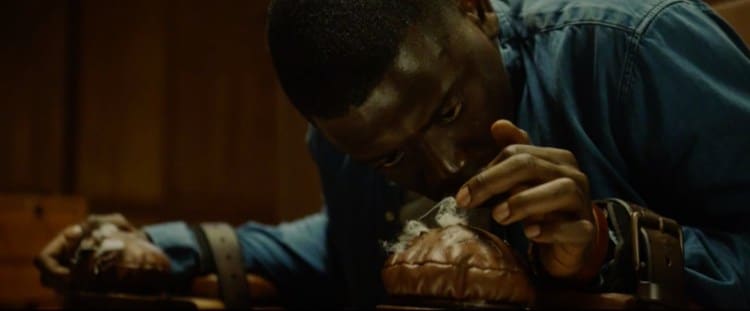
In the following scene, after an attendee has unbuckled Chris’s arms ties, expecting him to be unconscious from the hypnosis, we see Chris standing behind the attendee, fully awake, ready to make his escape. After knocking out the attendee, Chris pulls the stuffing from inside his ears. He used it to block out the sound that induces his hypnosis. Payoff.
This is a clever example of a plant that is set up and paid off within a single sequence and a great opportunity for the audience to predict the outcome of events before they are fully paid off.
Example 2:
Chris and his girlfriend, Rose, hit a deer in the road on the way to Rose’s parent’s house. Plant
Proudly hung on the wall of the family games room: the head of a deer. An eagle-eyed viewer will recognise the predator/prey metaphor. Payoff.
Example 3:
Chris is a smoker. Plant
Chris has cause for hypnosis. Payoff
This is a simpler example of the ways in which basic character traits can have meaningful consequences and help propel the plot. Every narrative and character choice has meaning and purpose, therefore giving every plant a satisfying payoff.
The Voyeurs
A salacious ode to Hitchcock and de Palma, The Voyeurs is premised upon the disturbing, twisted consequences of spying on the neighbours.
In many respects, The Voyeurs works as an example of the ways in which plants and payoffs can sometimes be too easy or too obvious.
Example 1:
For example, at the beginning of the film, Thomas and Pippa move into a new apartment. Sitting down to their first meal, Thomas hands Pippa his drink for her to taste. Repulsed, Pippa pulls a disgusted face, grilling Thomas over its contents. “It’s chlorophyll water, the secret to long life”, Thomas mocks.
Later, in a turn of events, the neighbours poison Thomas. How you may ask? You guessed it! The chlorophyll water. In light of this payoff, Thomas’s original line of dialogue turns out to be surprisingly clever. If only the plot twist itself carried this much weight.
Example 2:
Thomas is a musician.
When Pippa and Thomas require a means to listen in on their neighbours, Thomas has an array of sound equipment at his disposal. This doesn’t feel quite such a naturalistic plant and payoff. Instead, it feels a little too coincidental.
Why? Well, it doesn’t make Thomas a character susceptible to the plot’s developments (like Chris in Get Out with his smoking). Instead, it sets him up as a character perfectly suited to take advantage of the situation. So in part, he’s not vulnerable, he’s well-positioned. And secondly, being a musician is not a part of his character in a deep emotional sense. It’s only a part of his character in outline.
Example 3:
Pippa is an ophthalmologist.
Pippa uses her visual equipment to blind her neighbours at the close of the film.
Again, this example treads a fine line between plant and payoff and lucky coincidence. In a film premised entirely on the concept of vision, Pippa’s occupation seems all too convenient.

Plants and Payoffs: In Conclusion
The most provocative, interesting films will implement plants and payoffs in ways that are shrewd, surreptitious and challenging for the audience.
They will set things up that often feel strange or inconsequential at first but later will reveal as key factors in the plot. This isn’t about setting up the story too perfectly so that everything falls in to place. It’s about giving your choices meaning in a subtle manner.
In order to make things not feel coincidental, the plants have to feel a like a realistic part of the story at the time they are planted, even if they don’t make immediate sense. The plant and payoff have to be intrinsically linked in this sense. In other words, don’t set up a plant and then search for the payoff. The plant and payoff have to come together, then be separated by the narrative development.
Plants and payoffs are a key part of effective storytelling. And they always come down to the justification for your story and justification for the choices you make throughout your screenplay. When everything feels cohesive and purposeful plants and payoffs can be one of the most satisfying parts of the screenwriting and viewing process.
In Summary
Plants and payoffs are all about planting seeds for the audience. It’s about posing a question and following it up with an answer later on in the story.
A good plant is often one that seems out of place and confusing on first appearance. A great plant will typically be something that throws the audience off and seems out of place in that moment of the narrative. This way, it doesn’t seem like an obvious set-up for something that will happen later on but instead, an intriguing pull in to the story at that point.
The key to a good payoff is to layer it into the most pivotal part of the story or a part of the story where it can serve as the most meaningful. Moreover, a convincing payoff will feel intrinsically tied to the plant. A plant and payoff must come hand in hand in this sense, conceived together rather than the payoff coming after the fact of the plant.
– What did you think of this article? Share It, Like It, give it a rating, and let us know your thoughts in the comments box further down…
– Struggling with a script or book? Story analysis is what we do, all day, every day… check out our range of script coverage services for writers & filmmakers.
This article was written by Eleanor Donachie and edited by IS Staff.
Get *ALL* our FREE Resources
Tackle the trickiest areas of screenwriting with our exclusive eBooks. Get all our FREE resources when you join 60,000 filmmakers on our mailing list!

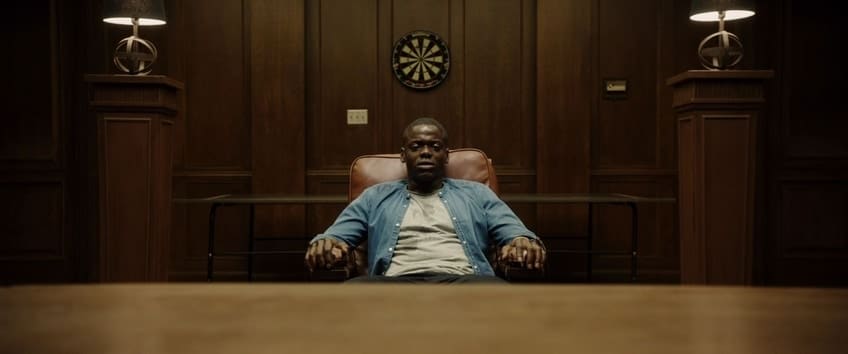
A really helpful article that goes beyond pointing out the obvious re plants and payoffs. Effective use of film examples too.
Glad you found this helpful, Angela!